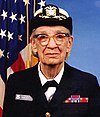W. Daniel Hillis
William Daniel "Danny" Hillis (born September 25, 1956 in Baltimore , Maryland ) is an American computer engineer and inventor, known for his development of parallel computers in the 1980s.
life and work
Hillis is the son of an epidemiologist with the United States Air Force , who lived with his family in several African countries ( Rwanda , Burundi , Zaire , Kenya ) while studying hepatitis . During this time Hillis was tutored by his mother, a bio-statistician. Hillis studied at the Massachusetts Institute of Technology (MIT), where he received his bachelor's degree in mathematics in 1978 and his master's degree in electrical engineering and computer science in 1981 , with a specialization in robotics . At MIT, he worked at the Logo programming language laboratory , where software and hardware were developed for computers in elementary schools and kindergartens. He continued this work at the toy manufacturer Milton Bradley Company and in Terrapin Software, which he founded. During this time he also built a functioning computer from the Tinkertoys construction kit , which was later exhibited in the Boston Computer Museum.
At the same time he was working on his doctoral thesis at MIT on parallel computers . In 1983 Hillis founded "Thinking Machines Corporation", which developed a parallel computer , the " Connection Machine ", from many networked processor nodes. At that time, Nobel Prize winner Richard Feynman , who was a friend of Hillis and who turned to basic research on computers (including quantum computers ) in the 1980s, also worked as a consultant in the company . In 1988 he received his doctorate from MIT with Gerald Jay Sussman (as well as Marvin Minsky , Claude Shannon ) . In his company he also pursued research work such as B. for the use of parallel computers in artificial intelligence . He advocates a philosophy similar to his teacher Marvin Minsky (“Society of Minds”), that the “secret” of human intelligence lies in massive parallelism, and that the transition from “artificial” to “human intelligence” is a question of quantity and no further ingredients required.
However, as the development of special parallel computers was soon overtaken by the development of the PC market (with the possibility of connecting many PCs together), the company declared bankruptcy in 1994. Hillis founded a new consultancy firm, DHSH, which advised the Walt Disney Company , among others , and worked at the MIT Media Lab. In 1996 he became a Disney Fellow and Vice President of Research and Development for Walt Disney Imagineering, the company's research and development division. Among other things, he developed ideas for the theme parks of Disney and z. B. a walking human-sized dinosaur robot.
In 2000 Hillis left Disney and founded “Applied Minds”, a technical consultancy firm, with Bran Ferren (the head of Walt Disney Imagineering). One of its offshoots was "Metaweb Technologies", founded in 2005 with the aim of developing techniques for semantic data storage on the Internet. Another was "Freebase", which was supposed to develop an open, distributed database architecture.
In 1993 Hillis, in view of the short-lived nature of storage technologies in the computer age, proposed the project of long-term storage of the “knowledge of mankind”, for which purpose they developed a mechanical clock of high accuracy and reliability (“ Clock of the Long Now ”). The clock, the prototype of which was completed in 1999, should run for at least 10,000 years, move a hand once a year and draw its energy from the climatic differences of the seasons. She is to be housed in a mountain in Nevada . This led to the establishment of the " Long Now Foundation " in 1996 by Hillis, Brian Eno , Stewart Brand , Esther Dyson and Mitch Kapor .
Hillis lives in Los Angeles . In 1989 he received the Grace Murray Hopper Award and in 2002 the Dan David Prize . In 1992 he was elected to the American Academy of Arts and Sciences .
Others
Hillis' clock project also plays a prominent role in the experimental film "My Avatar and Me" (2010/11) by Danish filmmakers Bente Milton and Mikkel Stolt, which thematizes the virtual world of Second Life and in which Hillis appears several times as himself.
Fonts
- Computer logic - that's how easy computers work. Bertelsmann, Munich 2001 (English original The Patterns on the Stone: The Simple Ideas that make computers work. 1999) (popular science book about computers and information technology)
- The Connection Machine. MIT Press Series in Artificial Intelligence, 1985, ISBN 0-262-08157-1 (his dissertation)
literature
- Steven Levy: The Mind of an Inventor. In: Newsweek. October 10, 2005
- Cathy Lazere: Out of Their Minds. The Lives and Discoveries of 15 Great Computer Scientists. Springer 1998
Web links
- Metaweb Technologies, Inc., owned by Hillis
- Biography of Goertzel
- Applied Minds, Inc., owned by Hillis
- John Battelle's blog: A Morning with Danny Hillis
- Biography at the Long Now Foundation
- Biography at edge.org
- "The Rise and Fall of Thinking Machines Corporation," Inc Magazine 1995
- Levy "The Mind of an Inventor", Newsweek 2005
- Biography when he was awarded the Dan Davis Prize in 2002
- Interview, Web of Stories
| personal data | |
|---|---|
| SURNAME | Hillis, W. Daniel |
| ALTERNATIVE NAMES | Hillis, William Daniel (full name); Hillis, Danny |
| BRIEF DESCRIPTION | American computer engineer |
| DATE OF BIRTH | September 25, 1956 |
| PLACE OF BIRTH | Baltimore |


